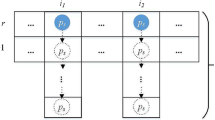Abstract
The biomolecules structure prediction problem (BSP) - especially the protein structure prediction (PSP) and the nucleic acids structure prediction - was introduced in the computational biology field approximately 45–50 years ago. The PSP on hydrophobic-polar lattice model (HP model) is a combinatorial optimisation problem, and consists in aims to minimize an arbitrary energy function associated with every native structure.
To solve the PSP problem, many metaheuristic methods were applied. Although the record-to-record travel algorithm (RRT) has proven useful in solving combinatorial optimisation problems, it has not been applied so far to solve the PSP problem.
In this paper, a mathematical modeling for PSP on the 2D HP rectangular lattice is developed and an adapted record-to-record travel algorithm (aRRT) is applied to address the combinatorial optimisation problem. For candidate solutions perturbation, a rotation and a diagonal move mutation operators were used.
A benchmark data set is used to test the RRT algorithm. The results obtained show that the algorithm is competitive when compared to the best published results. The main advantage of the RRT algorithm is that it is time-efficient, and requires small computational resources to obtain the same results as swarm intelligence algorithms.
Access this chapter
Tax calculation will be finalised at checkout
Purchases are for personal use only
Similar content being viewed by others
References
Anfinsen, C.B.: Principles that govern the folding of protein chains. Science 181(4096), 223–230 (1973)
Berger, B., Leighton, T.: Protein folding in the hydrophobic-hydrophilic (HP) model is np-complete. J. Comput. Biol. 5(1), 27–40 (1998). https://doi.org/10.1089/cmb.1998.5.27, https://doi.org/10.1089/cmb.1998.5.27, pMID: 9541869
Crescenzi, P., Goldman, D., Papadimitriou, C., Piccolboni, A., Yannakakis, M.: On the complexity of protein folding. J. Comput. Biol. 5(3), 423–465 (1998). https://doi.org/10.1089/cmb.1998.5.423, pMID: 9773342
Dill, K.A.: Theory for the folding and stability of globular proteins. Biochemistry 24, 1501 (1985)
Dinu, V., Trutia, E., Popa-Cristea, E., Popescu, A.: Biochimie medicală - mic tratat. Ed. Medicală, Bucureşti (2006)
Dueck, G.: New optimization heuristics: the great deluge algorithm and the record-to-record travel. J. Comput. Phys. 104(1), 86–92 (1993). https://doi.org/10.1006/jcph.1993.1010, http://www.sciencedirect.com/science/article/pii/S0021999183710107
Dueck, G., Scheuer, T.: Threshold accepting: a general purpose optimization algorithm appearing superior to simulated annealing. J. Comput. Phys. 90(1), 161–175 (1990). https://doi.org/10.1016/0021-9991(90)90201-B, http://www.sciencedirect.com/science/article/pii/002199919090201B
Garett, R.H., Grisham, C.M.: Biochemistry. Emily Barrosse, John J. Vondeling, 2nd edn. (1999)
Harrison, P.M., Chan, H.S., Prusiner, S.B., Cohen, F.E.: Thermodynamics of model prions and its implications for the problem of prion protein folding 11edited by a. r. fersht. J. Mol. Biol. 286(2), 593–606 (1999). https://doi.org/10.1006/jmbi.1998.2497, http://www.sciencedirect.com/science/article/pii/S0022283698924974
Huang, C., Yang, X., He, Z.: Protein folding simulations of 2D HP model by the genetic algorithm based on optimal secondary structures. Comput. Biol. Chem. 34(3), 137–142 (2010). https://doi.org/10.1016/j.compbiolchem.2010.04.002, http://www.sciencedirect.com/science/article/pii/S147692711000040X
Lau, K.F., Dill, K.A.: A lattice statistical mechanics model of the conformational and sequence spaces of proteins. Macromolecules 22(10), 3986–3997 (1989). https://doi.org/10.1021/ma00200a030
Liang, F., Hung Wong, W.: Evolutionary Monte Carlo for protein folding simulations. J. Chem. Phys. 115, 3374–3380 (2001). https://doi.org/10.1063/1.1387478
Mafarja, M., Abdullah, S.: A fuzzy record-to-record travel algorithm for solving rough set attribute reduction. Int. J. Syst. Sci. 46, 1–10 (2015). https://doi.org/10.1080/00207721.2013.791000
Mafarja, M.M., Abdullah, S.: Record-to-record travel algorithm for attribute reduction in rough set theory. J. Theor. Appl. Inf. Technol. 49, 507–513 (2013)
Mann, M., Backofen, R.: Exact methods for lattice protein models. Bio-Algorithms Med-Syst. 10(4), 213–225 (2014). https://doi.org/10.1515/bams-2014-0014, https://www.degruyter.com/view/journals/bams/10/4/article-p213.xml
Mansour, N., Kanj, F., Khachfe, H.: Particle swarm optimization approach for protein structure prediction in the 3D HP model. Interdiscip. Sci.: Comput. Life Sci. 4(3), 190–200 (2012). https://doi.org/10.1007/s12539-012-0131-z
Neumaier, A.: Molecular modeling of proteins and mathematical prediction of protein structure. SIAM Rev. 39(3), 407–460 (1997). https://doi.org/10.1137/S0036144594278060
Rashid, M.A., Khatib, F., Hoque, M.T., Sattar, A.: An enhanced genetic algorithm for ab initio protein structure prediction. IEEE Trans. Evol. Comput. 20(4), 627–644 (2016)
Schittekat, P.: Deconstructing record-to-record travel for the capacitated vehicle routing problem. Oper. Res. Manag. Sci. Lett. 1, 17–27 (2018)
Shmygelska, A., Hoos, H.H.: An ant colony optimisation algorithm for the 2D and 3D hydrophobic polar protein folding problem. BMC Bioinform. 6(1), 30 (2005). https://doi.org/10.1186/1471-2105-6-30
Sima, I., Parv, B.: Protein folding simulation using combinatorial whale optimization algorithm. In: 2019 21st International Symposium on Symbolic and Numeric Algorithms for Scientific Computing (SYNASC), pp. 159–166 (2019)
Splettstoesser, T.: “\({\copyright }\) [Thomas Splettstoesser]/ Adobe Stock” Behance. Protein Folding Funnel. https://www.behance.net/gallery/10952399/Protein-Folding-Funnel. Accessed 02 Mar 2021
Turabieh, H.: A hybrid genetic algorithm for 2D protein folding simulations. Int. J. Comput. Appl. 139, 38–43 (2016). https://doi.org/10.5120/ijca2016909127
Unger, R., Moult, J.: Genetic algorithms for protein folding simulations. J. Mol. Biol. 231(1), 75–81 (1993). https://doi.org/10.1006/jmbi.1993.1258, http://www.sciencedirect.com/science/article/pii/S0022283683712581
Yang, C.H., Wu, K.C., Lin, Y.S., Chuang, L.Y., Chang, H.W.: Protein folding prediction in the HP model using ions motion optimization with a greedy algorithm. BioData Min. 11(1), 17 (2018). https://doi.org/10.1186/s13040-018-0176-6
Zhou, C., Hou, C., Zhang, Q., Wei, X.: Enhanced hybrid search algorithm for protein structure prediction using the 3D-HP lattice model. J. Mol. Model. 19(9), 3883–3891 (2013)
Acknowledgment
The authors would like to thank Prof. Univ. Dr. Bazil Parv for his professional guidance and valuable support.
Author information
Authors and Affiliations
Corresponding author
Editor information
Editors and Affiliations
Rights and permissions
Copyright information
© 2021 Springer Nature Switzerland AG
About this paper
Cite this paper
Sima, I., Cristea, DM. (2021). Record-to-Record Travel Algorithm for Biomolecules Structure Prediction. In: Gervasi, O., et al. Computational Science and Its Applications – ICCSA 2021. ICCSA 2021. Lecture Notes in Computer Science(), vol 12949. Springer, Cham. https://doi.org/10.1007/978-3-030-86653-2_33
Download citation
DOI: https://doi.org/10.1007/978-3-030-86653-2_33
Published:
Publisher Name: Springer, Cham
Print ISBN: 978-3-030-86652-5
Online ISBN: 978-3-030-86653-2
eBook Packages: Computer ScienceComputer Science (R0)




